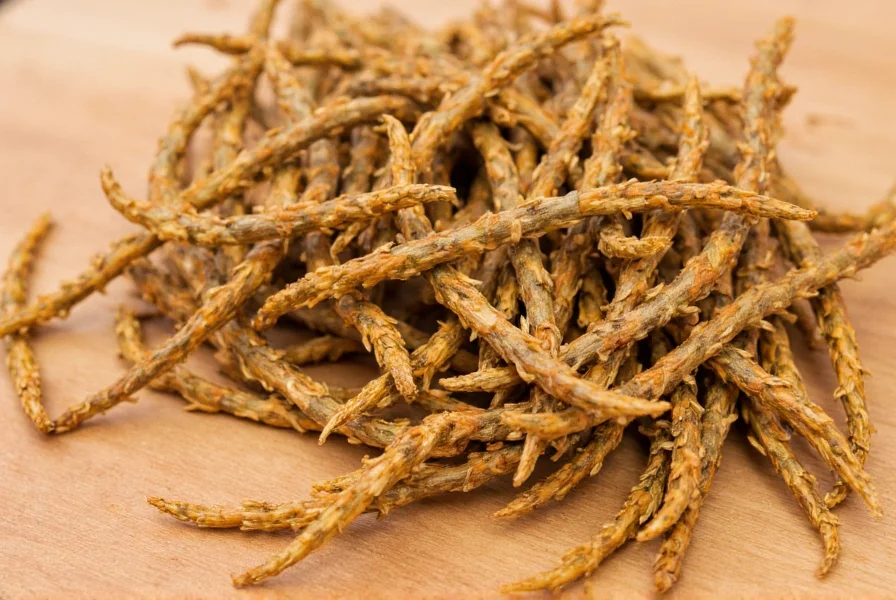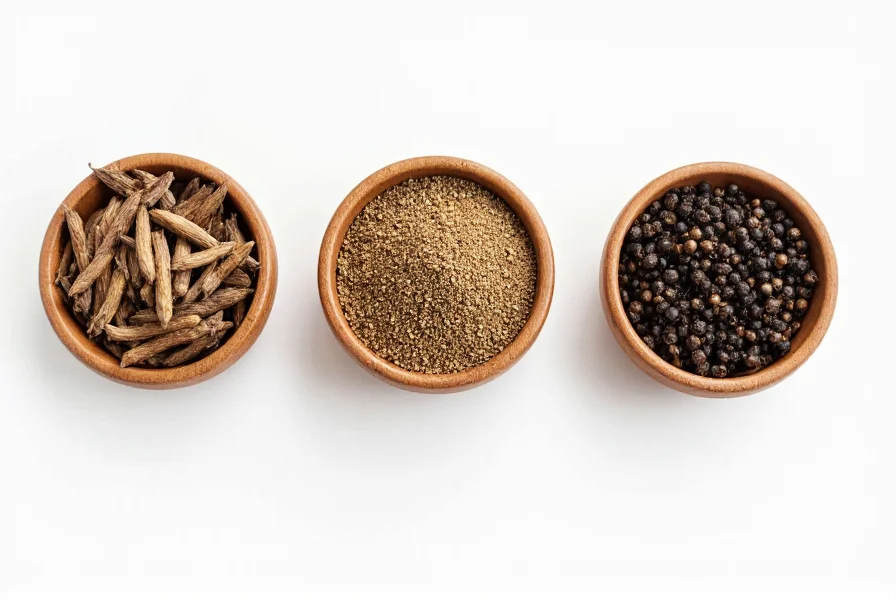While black pepper dominates modern kitchens, long pepper represents one of the world's oldest traded spices, cherished in ancient Roman and Ayurvedic traditions. Its unique composition creates a different culinary experience that sophisticated palates increasingly seek for authentic historical recipes and contemporary gourmet applications.
Ancient Origins and Historical Significance
Long pepper's journey began over 4,000 years ago in northeastern India, where archaeological evidence confirms its use in the Indus Valley Civilization. Unlike black pepper (Piper nigrum), which grows as individual berries, long pepper develops as a catkin—a slender spike containing numerous tiny fruits. This distinctive structure earned it the Sanskrit name Pippali, later becoming Piper longum in Latin.
Historical records show long pepper commanded higher value than black pepper in ancient Rome, featuring prominently in Apicius' De Re Coquinaria, the world's oldest surviving cookbook. The spice traveled along early trade routes to Egypt, Greece, and eventually Europe, where it remained popular until the 15th century when black pepper's easier cultivation led to its decline. Recent culinary rediscovery has revived interest in this complex spice among chefs seeking authentic historical flavors.

Botanical Characteristics and Growing Conditions
Long pepper thrives in tropical climates with high humidity and well-drained soil, primarily cultivated in India's Assam region, Indonesia, and Nepal. The perennial vine produces catkins measuring 2-8 cm long that turn from green to brown as they mature. Harvest occurs just before full ripening when the spikes contain maximum piperine—the compound responsible for both heat and potential health benefits.
Unlike black pepper's single berry processing, long pepper requires careful sun-drying of entire catkins. This preservation method maintains the spice's complex flavor compounds, including piperine, beta-caryophyllene, and terpenes that create its signature warmth without overwhelming sharpness.
Flavor Profile and Culinary Applications
Understanding long pepper flavor profile reveals why chefs value it despite its higher cost. The taste unfolds in distinct stages:
| Stage | Flavor Notes | Duration |
|---|---|---|
| Initial | Floral, sweet | 2-3 seconds |
| Mid-palate | Warm spice (cinnamon, nutmeg) | 5-7 seconds |
| Finish | Gentle heat with citrus undertones | 15-20 seconds |
This layered experience makes long pepper particularly valuable for how to use long pepper in cooking scenarios where black pepper would dominate. It shines in:
- Cream-based sauces (replaces black pepper without curdling)
- Marinades for poultry and fish (complements delicate proteins)
- Chocolate desserts (enhances cocoa notes)
- Spiced wines and mulled beverages
- Traditional Indian medicines (Ayurvedic preparations)
Nutritional Composition and Traditional Uses
Research into long pepper health benefits reveals promising compounds beyond culinary applications. Each gram contains:
- 5-7% piperine (higher bioavailability than black pepper)
- Significant calcium and iron content
- Antioxidant polyphenols
- Volatile oils with antimicrobial properties
Ayurvedic medicine has utilized long pepper for centuries in Trikatu formulations to enhance digestion and nutrient absorption. Modern studies suggest potential anti-inflammatory effects, though more research is needed to confirm therapeutic applications. Unlike black pepper, long pepper's compounds appear more stable during cooking, potentially preserving more beneficial properties in finished dishes.
Practical Usage Guide for Home Cooks
When exploring where to buy long pepper, specialty spice shops and reputable online retailers offer the best quality. Look for:
- Deep brown color (avoid pale or blackened specimens)
- Flexible spikes (brittle indicates age)
- Strong aromatic scent when crushed
Proper storage maintains freshness for up to 18 months:
- Keep whole catkins in airtight glass containers
- Store in cool, dark pantry (not refrigerator)
- Grind only before use for maximum flavor retention
For long pepper substitute situations, combine equal parts black pepper and allspice, though this only approximates the complex profile. When substituting long pepper for black pepper, use a 1:1.5 ratio (less long pepper needed due to concentrated flavor).

Signature Recipes Featuring Long Pepper
These applications demonstrate why chefs seek this ancient spice:
Long Pepper Beurre Blanc
Substitute 1/2 teaspoon freshly ground long pepper for black pepper in classic beurre blanc. The spice integrates seamlessly without curdling the emulsion, adding warmth that complements seafood beautifully.
Spiced Chocolate Truffles
Add 1/4 teaspoon long pepper powder to dark chocolate ganache before chilling. The subtle heat enhances cocoa notes without overwhelming the palate—a technique used in Mesoamerican chocolate preparations centuries before European contact.
Understanding Long Pepper vs Black Pepper
The key differences between these spices explain their distinct culinary roles:
- Structure: Long pepper uses entire catkin; black pepper uses individual berries
- Flavor development: Long pepper offers layered progression; black pepper delivers immediate sharpness
- Heat duration: Long pepper's warmth lingers 3x longer than black pepper
- Culinary application: Long pepper works in delicate dishes where black pepper would dominate
- Historical value: Long pepper was twice as expensive as black pepper in ancient Rome
These distinctions make long pepper vs black pepper comparisons essential for understanding when each spice best serves a recipe. While black pepper provides reliable sharpness, long pepper offers complexity that elevates sophisticated preparations.
Frequently Asked Questions
What is the difference between long pepper and black pepper?
Long pepper (Piper longum) consists of entire catkin spikes containing multiple fruits, while black pepper (Piper nigrum) uses individual dried berries. Long pepper delivers a more complex flavor profile with initial sweetness, warm spice notes, and lingering heat, whereas black pepper provides immediate sharpness. Historically, long pepper was more valuable and widely used before black pepper became dominant in the 15th century.
Can I substitute long pepper for black pepper in recipes?
Yes, but with adjustments. Use a 1:1.5 ratio (less long pepper needed) since its flavor is more concentrated. For every teaspoon of black pepper, use 2/3 teaspoon long pepper. Note that long pepper works better in delicate dishes like cream sauces, fish preparations, and desserts where black pepper might dominate. In robust meat rubs or hearty stews, black pepper may still be preferable.
How should I store long pepper to maintain freshness?
Store whole long pepper spikes in an airtight glass container away from light and heat. Keep in a cool, dark pantry (not the refrigerator, which introduces moisture). Properly stored, long pepper maintains peak flavor for 12-18 months. For best results, grind only immediately before use, as ground spice loses volatile compounds rapidly. Check freshness by crushing a small piece—if the aroma is weak or musty, it's time to replace your supply.
Does long pepper have any health benefits?
Long pepper contains higher concentrations of piperine than black pepper, which may enhance nutrient absorption and exhibit anti-inflammatory properties. Traditional Ayurvedic medicine uses it in Trikatu formulations to support digestion. Preliminary research suggests potential benefits, but more clinical studies are needed to confirm therapeutic applications. As with any spice, consume in culinary amounts as part of a balanced diet rather than relying on it for medicinal purposes.
Why is long pepper less common than black pepper today?
Long pepper declined in popularity after the 15th century because black pepper is easier to cultivate and harvest. Black pepper vines produce higher yields with less labor-intensive processing, as each berry can be harvested individually when ripe. Long pepper requires harvesting entire catkins at precise maturity. Additionally, black pepper's sharper flavor suited evolving European palates. Recent culinary rediscovery has increased availability, though it remains a specialty item compared to ubiquitous black pepper.











 浙公网安备
33010002000092号
浙公网安备
33010002000092号 浙B2-20120091-4
浙B2-20120091-4